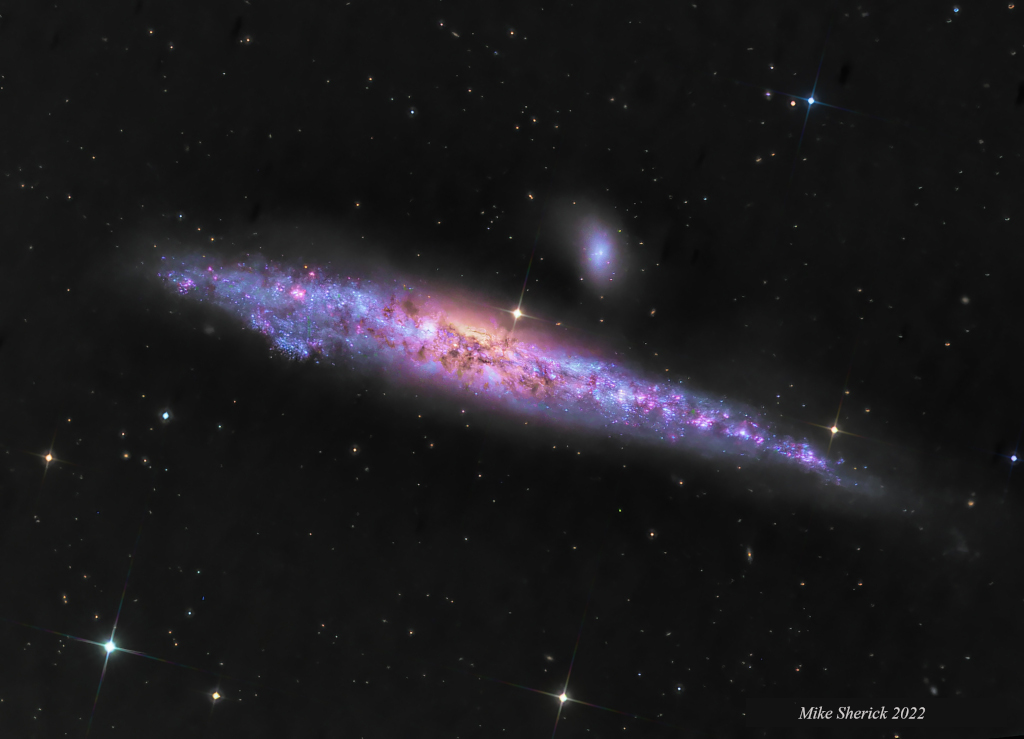
NGC 4631: The Whale Galaxy
Add to Favorites
NGC 4631 is a big beautiful spiral galaxy. Seen edge-on, it lies only 25 million light-years away in the well-trained northern constellation Canes Venatici. The galaxy's slightly distorted wedge shape suggests to some a cosmic herring and to others its popular moniker, The Whale Galaxy. Either way, it is similar in size to our own Milky Way. In this sharp color image, the galaxy's yellowish core, dark dust clouds, bright blue star clusters, and red star forming regions are easy to spot. A companion galaxy, the small elliptical NGC 4627 is just above the Whale Galaxy. Faint star streams seen in deep images are the remnants of small companion galaxies disrupted by repeated encounters with the Whale in the distant past. The Whale Galaxy is also known to have spouted a halo of hot gas glowing in X-rays.
2022-10-06 Michael Sherick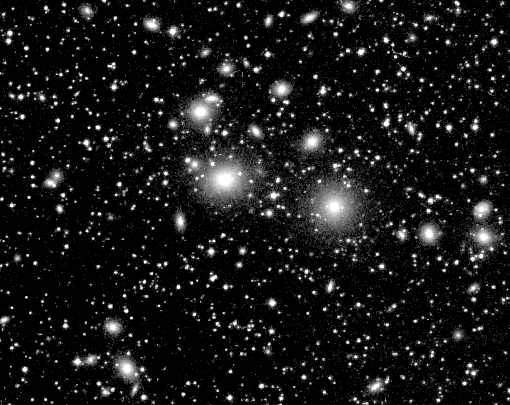
The Perseus Cluster of Galaxies Credit:
Add to Favorites
Here is one of the largest objects that anyone will ever see on the sky. Each of the fuzzy blobs in the above picture is a galaxy, together making up the Perseus Cluster, one of the closest clusters of galaxies. We view the cluster through the foreground of faint stars in our own Milky Way Galaxy. It takes light roughly 300 million years to get here from there, so we only see this cluster as it existed during the age of the dinosaurs. Also known as Abell 426, the center of Perseus cluster is a prodigious source of X-ray radiation, and so helps astronomers study how clusters formed and how gas and dark matter interact. The Perseus Cluster of Galaxies is part of the Pisces-Perseus supercluster of galaxies, which spans over 15 degrees and contains over 1000 galaxies.
1997-04-26 STScI, AAO, UK-PPARC, ROE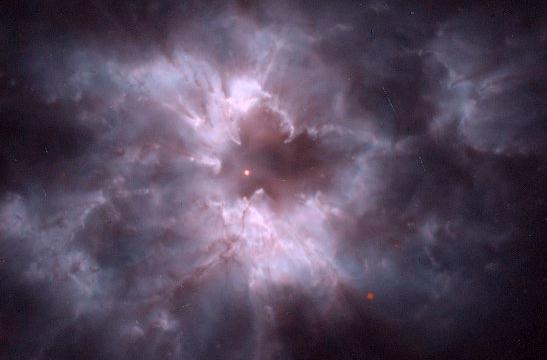
NGC 2440: Cocoon of a New White Dwarf
Add to Favorites
Like a butterfly, a white dwarf star begins its life by casting off a cocoon that enclosed its former self. In this analogy, however, the Sun would be a caterpillar and the ejected shell of gas would become the prettiest of all! The above cocoon, the planetary nebula designated NGC 2440, contains one of the hottest white dwarf stars known. The white dwarf can be seen as the bright dot near the photo's center. Our Sun will eventually become a "white dwarf butterfly", but not for another 5 billion years. The above false color image and was post-processed by Forrest Hamilton.
1999-07-03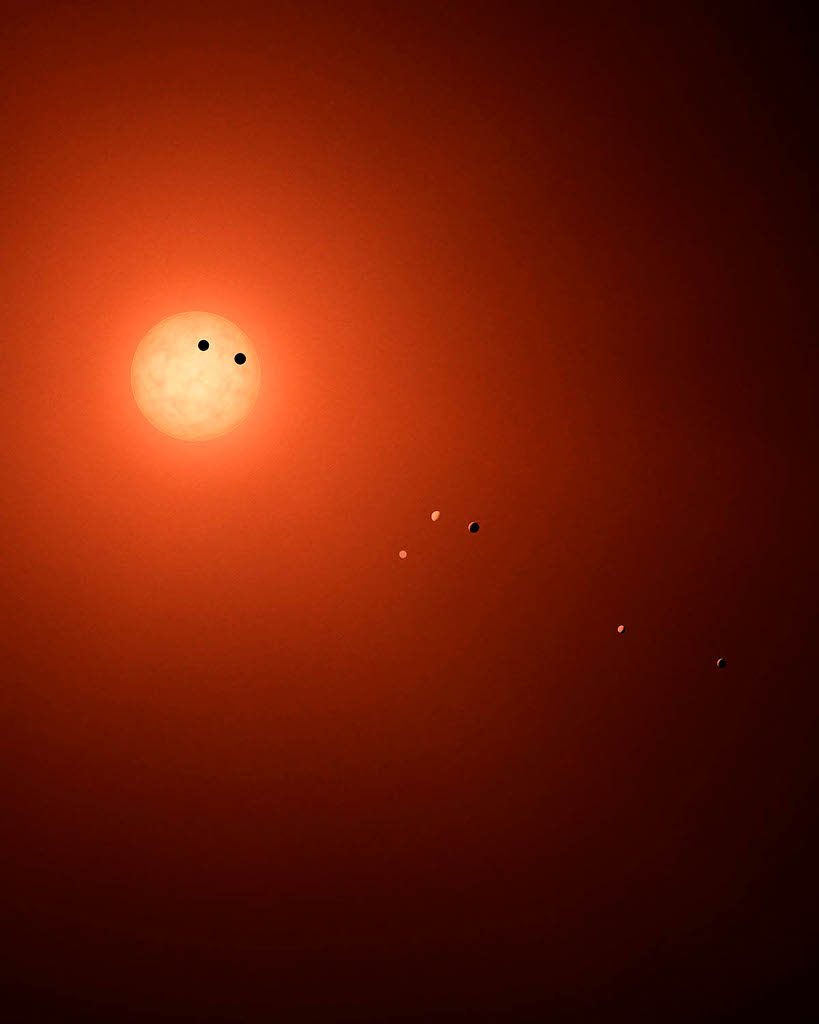
Seven Worlds for TRAPPIST-1
Add to Favorites
Seven worlds orbit the ultracool dwarf star TRAPPIST-1, a mere 40 light-years away. In May 2016 astronomers using the Transiting Planets and Planetesimals Small Telescope (TRAPPIST) announced the discovery of three planets in the TRAPPIST-1 system. Just announced, additional confirmations and discoveries by the Spitzer Space Telescope and supporting ESO ground-based telescopes have increased the number of known planets to seven. The TRAPPIST-1 planets are likely all rocky and similar in size to Earth, the largest treasure trove of terrestrial planets ever detected around a single star. Because they orbit very close to their faint, tiny star they could also have regions where surface temperatures allow for the presence of liquid water, a key ingredient for life. Their tantalizing proximity to Earth makes them prime candidates for future telescopic explorations of the atmospheres of potentially habitable planets. All seven worlds appear in this artist's illustration, an imagined view from a fictionally powerful telescope near planet Earth. Planet sizes and relative positions are drawn to scale for the Spitzer observations. The system's inner planets are transiting their dim, red, nearly Jupiter-sized parent star.
2017-02-23
NGC 2685: The Helix Galaxy
Add to Favorites
What is going on with this galaxy? NGC 2685 is a confirmed polar ring galaxy - a rare type of galaxy with stars, gas and dust orbiting in rings perpendicular to the plane of a flat galactic disk. The bizarre configuration could be caused by the chance capture of material from another galaxy by a disk galaxy, with the captured debris strung out in a rotating ring. Still, observed properties of NGC 2685 suggest that the rotating helix structure is remarkably old and stable. In this sharp view of the peculiar system also known as Arp 336 or the Helix galaxy, the strange, perpendicular rings are easy to trace as they pass in front of the galactic disk, along with other disturbed outer structures. NGC 2685 is about 50,000 light-years across and 40 million light-years away in the constellation of the Great Bear (Ursa Major). Piece it All Together: Astronomy Puzzle of the Day
2025-07-14 Stefan Thrun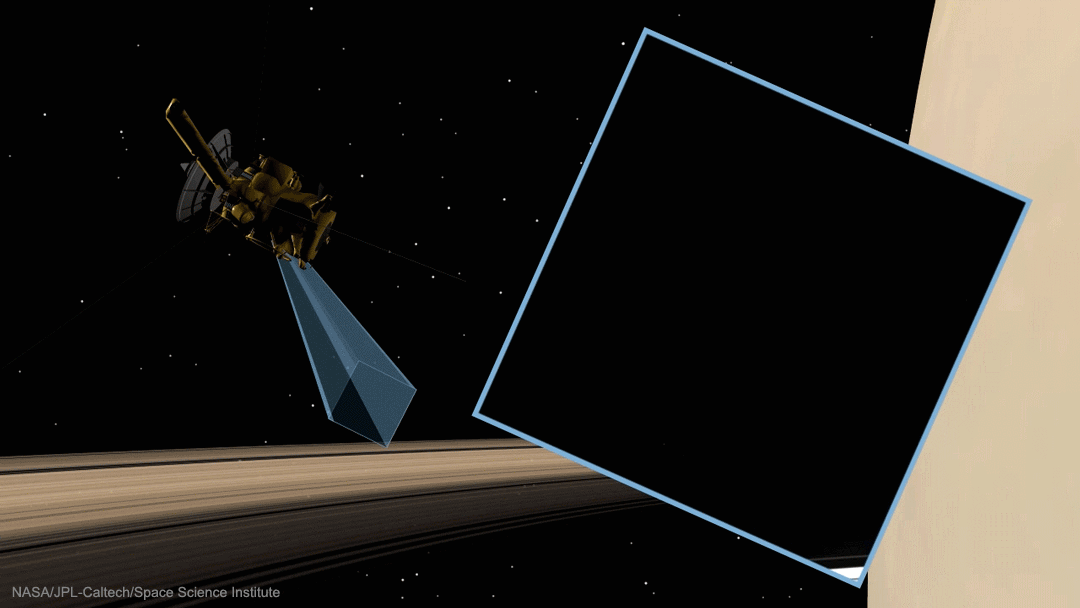
Saturn's Rings from the Inside Out
Add to Favorites
What do Saturn's rings look like from Saturn? Images from the robotic spacecraft Cassini are providing humanity with this unprecedented vantage point as it nears the completion of its mission. Previous to Cassini's Grand Finale orbits, all images of Saturn's majestic ring system were taken from outside of the rings looking in. Pictured in the inset is the remarkable video, while the spacecraft's positions are depicted in the surrounding animation. Details of the complex rings are evident as the short time-lapse sequence begins, while the paper-thin thickness of the rings becomes apparent near the video's end. The featured images were taken on August 20. Cassini has only a few more orbits around Saturn left before it is directed to dive into the giant planet on September 15.
2017-09-04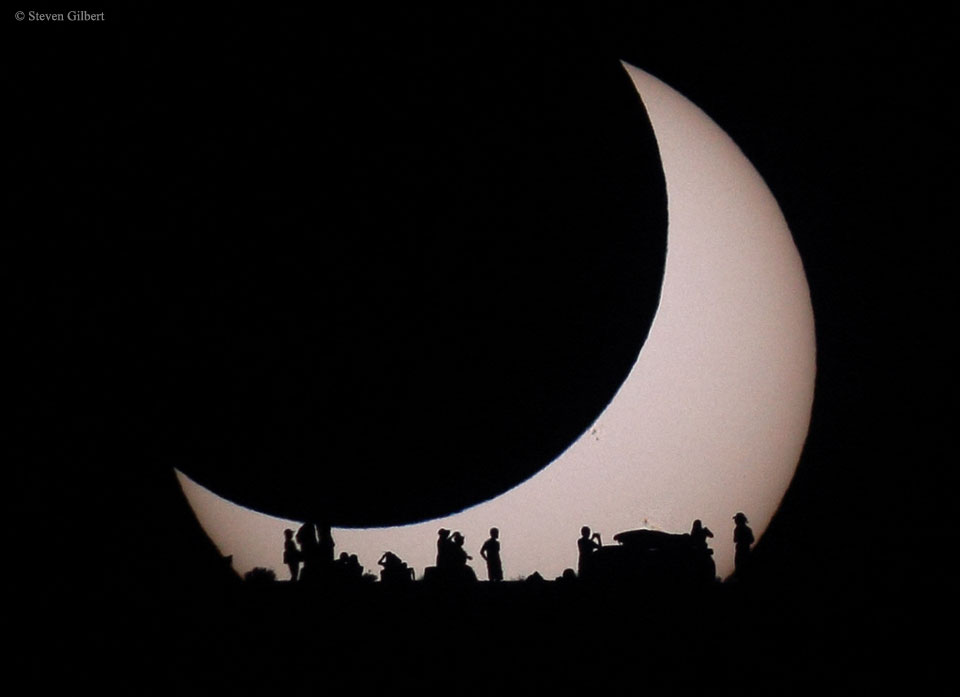
Contemplating the Sun
Add to Favorites
Have you contemplated your home star recently? Featured here, a Sun partially eclipsed on the top left by the Moon is also seen eclipsed by earthlings contemplating the eclipse below. The spectacular menagerie of silhouettes was taken in 2012 from the Glen Canyon National Recreation Area near Page, Arizona, USA, where park rangers and astronomers expounded on the unusual event to interested gatherers. Also faintly visible on the Sun's disk, just to the lower right of the dark Moon's disk, is a group of sunspots. Although a partial solar eclipse by the Moon is indeed a good chance to contemplate the Sun, a great chance -- and one that is significantly more rare -- will occur next week when the Sun undergoes a partial eclipse by the planet Mercury.
2016-05-01 Steven Gilbert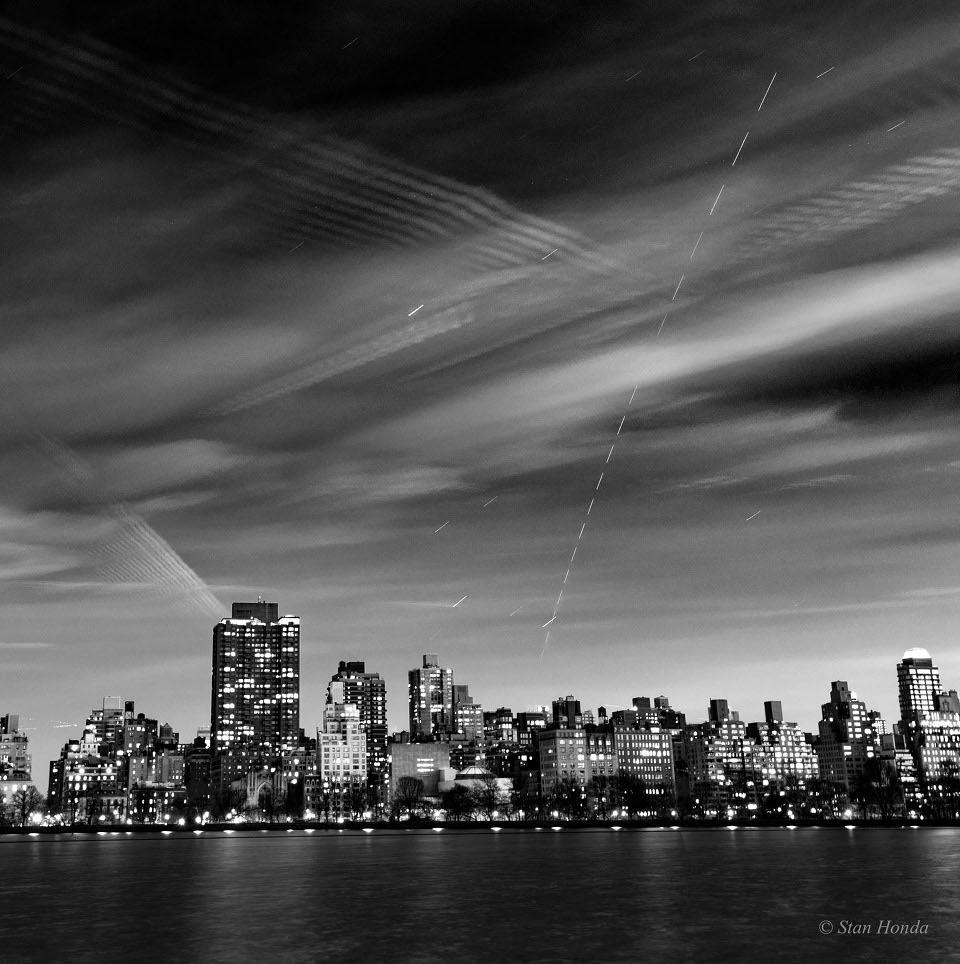
Manhattan Skylines
Add to Favorites
City lights shine along the upper east side of Manahattan in this dramatic urban night skyscape from February 13. Composed from a series of digital exposures, the monochrome image is reminiscent of the time when sensitive black and white film was a popular choice for dimly lit night and astro-photography. Spanning 2 minutes and 40 seconds, the combined 22 frames look across the reservoir in New York City's Central Park. Stars trail in the time-lapse view while drifting clouds make patterns in the sky. Traced from top to bottom, the dashed line in the surreal scene is the International Space Station still in sunlight and heading for the southeast horizon. The short time intervals between the exposures leave gaps in the space station's bright trail.
2018-02-17 Stan Honda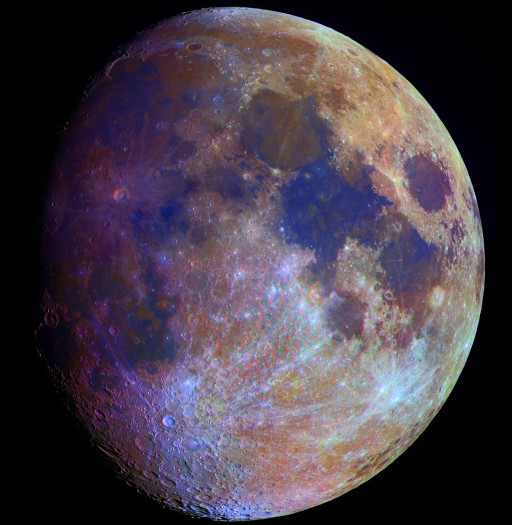
The Color of the Moon
Add to Favorites
rth's Moon is normally seen in subtle shades of grey or yellow. But small color differences have been greatly exaggerated to make this dramatic mosaic image of the Moon's gibbous phase. The familiar Sea of Tranquility (Mare Tranquillitatis) is the blue area right of center. White lines radiate from the crater Tycho at bottom left, while purplish tones mottle the crater Copernicus left of center. Though exaggerated, the different colors are recognized to correspond to real differences in the chemical makeup of the lunar surface - blue hues reveal titanium rich areas while orange and purple colors show regions relatively poor in titanium and iron. Calibrated by rock samples from the Apollo missions, similar multicolor images from spacecraft have been used to explore the Moon's global surface composition.
2006-02-16 Johannes Schedler (Panther Observatory)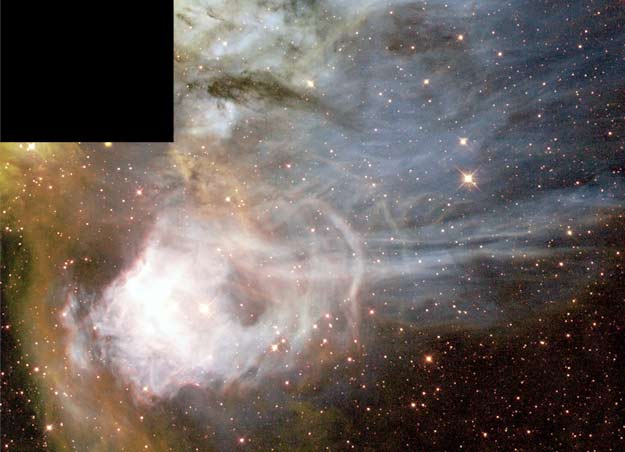
N44C: A Nebular Mystery
Add to Favorites
Why is N44C glowing so strangely? The star that appears to power the nebula, although young and bright, does not seem hot enough to create some of the colors observed. A search for a hidden hotter star in X-rays has come up empty. One hypothesis is that the known central star has a neutron star companion in a very wide orbit. Hot X-rays might only then be emitted during brief periods when the neutron star nears the known star and crashes through a disk of surrounding gas. Future observations might tell. N44C, pictured in the above Hubble Space Telescope image, is an emission nebula in the Large Magellanic Cloud, a neighboring galaxy to our Milky Way Galaxy. Flowing filaments of colorful gas and dark dust far from the brightest region are likely part of the greater N44 complex. It would take light about 125 years to cross N44C.
2002-05-14